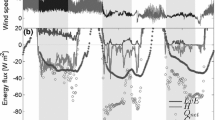Abstract
A new method of parametric spectral calculation based on the ensemble average technique, which is a natural expansion of the Burg's maximum entropy method, is proposed. This method is applied to a set of numerical simulation data which simulate turbulent velocity fluctuations data measured in the canine aorta with a hot-film anemometer. The autoregressive order of the spectral calculation is chosen by the minimum AIC (Akaike's information criteria) method. It is shown that the proposed method used with the minimum AIC method has a very good performance calculating smooth averaged spectra in the short-time quasisteady spectral analysis of nonstationary processes such as turbulence in the aorta.
Similar content being viewed by others
References
Akaike, H. (1969a) Fitting autoregressive models for prediction.Ann. Inst. Statist Math.,21, 243–247.
Akaike, H. (1969b) Power spectrum, estimation through autoregressive model fitting.——Ibid.,21., 407–419.
Akaike, H. (1974) A new look at the statistical model identification.IEEE Trans.,AC-19, 716–723.
Anderson, N. (1974) On the calculation of filter coefficients for maximum entropy spectral analysis.Geophysics,39, 69–72.
Bendat, J. S. andPiersol, A. G. (1971)Random data analysis and measurement procedures. Wiley-Interscience, New York, London, Sydney, Toronto, 325.
Bradshaw, P. (1971)An introduction to turbulence and its measurement. Pergamon, Oxford, 22.
Burg, J. P. (1967) Paper presented at the 37th Annual International Meeting, Society of Exploring Geophysicists, Oklahoma City, Oklahoma, 31st October 1967. Reprinted inModern spectrum analysis.Childers, D. G. (Ed.), IEEE Press, New York, 1978.
Burg, J. P. (1972) The relationship between maximum entropy spectra and maximum likelihood spectra.Geophysics,37, 375–376.
Chen, W. Y. andStegen, G. R. (1974) Experiments with maximum entropy power spectra of sinusoids.J. Geophys., Res.,79, 3019–3022.
Deshpande, M. D. andGiddens, D. P. (1980) Turbulence measurements in a constricted tube.J. Fluid Mech.,97, 65–89.
Giddens, D. P. andKitney, R. I. (1983) Autoregressive spectral estimation of poststenotic blood flow disturbance.J. Biomech. Eng.,105, 401–404.
Haykin, S. andKesler, S. (1979) Prediction error filtering and maximum entropy spectral estimation. InNonlinear methods of spectral analysis. Topics in applied physics, vol. 34.Haykin, S. (Ed.), Springer-Verlag, Berlin, Heidelberg, New York, 9–72.
Herring, R. W. (1980) The cause of line splitting in Burg maximum-entropy spectral analysis.IEEE Trans. ASSP,-28, 629–701.
Hino, M., Kashiwayanagi, M., Nakayama, A. andHara, T. (1983) Experiments on the turbulence statistics and the structure of a reciprocating oscillatory flow.,J. Fluid Mech.,131, 363–400.
Jansen, B. H., Bourne, J. R. andWand, J. W. (1981) Autoregressive estimation of short segment spectra for computerised EEG analysis.IEEE Trans.,BME-28, 630–638.
Jones, H. R. (1976) Autoregression order selection.Geophysics,41, 771–773
Kawai, S. (1979) Generation of initial wavelets by instability of a coupled shear flow and their evolution to wind waves.J. Fluid Mech.,93, 661–703.
Kay, S. M. (1979) The effects of noise on the autoregressive spectral estimator.IEEE Trans. ASSP,-27, 478–485.
Kay, S. M. (1980) Noise compensation for autoregressive spectral estimates.IEEE Trans.,ASSP-28, 292–303.
Khalifa, A. M. A. andGiddens, D. P. (1978) Analysis of disorder in pulsatile flows with application to post-stenotic blood velocity measurement in dogs.J. Biomech.,11, 129–141.
Khalifa, A. M. A. andGiddens, D. P. (1981) Characterisation and evolution of poststenotic flow disturbances.——Ibid..,14, 279–296.
Kitney, R. I. andGiddens, D. P. (1982) Extraction and characterisation of underlying velocity waveforms in poststenotic flow.IEE Proc. A,129, 651–662.
Kitney, R. I. andGiddens, D. P. (1983) Analysis of blood velocity waveforms by phase shift averaging and autoregressive spectral estimation.J. Biomech. Eng.,105, 398–401.
Lacoss, R. T. (1971) Data adaptive spectral analysis methods.Geophysics,36, 661–675.
Lawn, C. J. (1971) The determination of the rate of dissipation in turbulent pipe flow.J. Fluid Mech.,48, 477–505.
Parker, K. H. (1977) Instability in arterial blood flow. InCardiovascular flow dynamics and measurements Hwang, N. H. C. andNorman, N. A. (Eds.), University Park Press, Baltimore, 633–663.
Radoski, H. R., Fougere, P. F. andZawalick, E. J. (1975) A comparison of power spectral estimates and applications of the maximum entropy method.J. Geophys. Res.,80, 610–625.
Sakai, H. (1979) Statistical properties of AR spectral analysis.IEEE Trans. ASSP,-27, 402–409.
Ulrych, T. J. (1972) Maximum entropy power spectrum of truncated sinusoids.J. Geophys. Res.,77, 1396–1400.
Ulyrch, T. J. andBishop, T. N. (1975) Maximum entropy spectral analysis and autoregressive decomposition.Rev. Geophys. Space Phys.,13, 183–200.
Ulrych, T. J. andOoe, M. (1979) Autoregressive and mixed autoregressive-moving average models and spectra. InNonlinear methods of spectral analysis. (Topics in applied physics, vol. 34.) Haykin, S. (Ed.), Springer-Verlag, Berlin, Heidelberg, New York, 73–125.
Yamaguchi, T., Yoshikawa, T., Kikkawa, S. andSugawara, M. (1980a) Turbulence intensity measured in the centre of canine ascending aorta with a hot-film anemometer. (In Japanese.)Trans. Soc. Instr. Control Eng. (Japan) 16, 754–760.
Yamaguchi, T., Yoshikawa, T., Kikkawa, S. andSugawara, M. (1980b) A method for the analysis of turbulence measured in the canine aorta with a hot-film anemometer. (In Japanese.) ——Ibid.,16, 910–915.
Yamaguchi, T., Kikkawa, S., Tanishita, K. andSugawara, M. (1981) Spectrum analysis of turbulence in the canine ascending aorta. (In Japanese)Jpn. J. Med. Electron. Biol. Eng.,19, 259–266.
Yamaguchi, T., Kikkawa, S., Tanishita, K., Sugawara, M. andParker, K. H. (1982) Spectrum analysis of turbulence in the aorta. InBiomechanics: principles and applications.Huisks, R., van Campen, D. andDe Wijn, J. (Eds.), Martinus Nijhoff, The Hague, Boston, London, 359–366.
Yamaguchi, T., Kikkawa, S., Yoshikawa, T..,Tanishita, K. andSugawara, M. (1983) Measurement of turbulence intensity in the centre of the canine ascending aorta with a hot-film anemometer.J. Biomech. Eng.,105, 177–187.
Author information
Authors and Affiliations
Rights and permissions
About this article
Cite this article
Yamaguchi, T., Kikkawa, S. & Parker, K.H. Simulation of nonstationary spectral analysis of turbulence in the aorta using a modified autoregressive or maximum entropy (AR/ME) method. Med. Biol. Eng. Comput. 25, 533–542 (1987). https://doi.org/10.1007/BF02441746
Received:
Accepted:
Issue Date:
DOI: https://doi.org/10.1007/BF02441746




